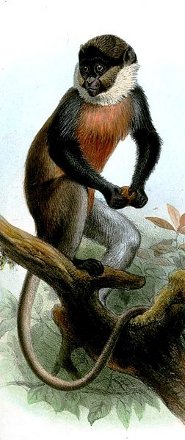 The Red-Bellied Monkey (Cercopithecus erythrogaster) is a native of Benin and Nigeria. They are unique because of their small stature, coloring patterns, and cheek pouches. This beautiful little monkeys became officially endangered in 2000, mainly due to destruction of their habitat by humans.
The Red-Bellied Monkey (Cercopithecus erythrogaster) is a native of Benin and Nigeria. They are unique because of their small stature, coloring patterns, and cheek pouches. This beautiful little monkeys became officially endangered in 2000, mainly due to destruction of their habitat by humans. Physical Attributes
This petite species is approximately 46 cm (18 inches) long. The female weighs around 2 kg (4.4 pounds), and the male weighs around 4.5kg (10 pounds). The monkey is famous for its red belly and white throat. The combination of colors makes them unique and easy to identify. They are arboreal, using all four legs to move horizontally along tree branches. They do occasionally leap, but prefer the safer method of using all four limbs.
Food Sources
They are primarily fruit eaters, but they are opportunistic and will consume insects, leaves, and even crops when available. They have cheek pouches that allow them to forage for food, then store it until they reach a safe place to eat. This unique feature separates them from other monkeys in their area. They are also able to carry large amounts of food in these pouches to other members of their group.
Habitat
The Red Bellied Monkey lives in wetlands along rivers and forests in Southwestern Nigeria and Southern Benine.
Social Life
The monkeys like to live in small groups of five to ten. However, there have been groups as large as thirty observed. They are social within the group, but separate themselves from other groups. They are polygynous and breed every one to five years. Females have a single baby after 150 – 213 days of gestation. In captivity, these fascinating creatures can live up to twenty four years. Due to their endangered status, little is known about their life span in the wild.
Communication
The monkeys use various methods of nonverbal communication to warn off animals invading their territory. Staring, staring with open mouths, and head bobbing are all different warning methods they use. They also employ verbal communication, but little is known about the methods and meanings.
These peculiar creatures are trying to make a comeback in captivity. They are robust and reproduce regularly. The destruction of their habitat has made it impossible for them to maintain themselves in their natural habitat. Very few monkeys have the cheek pouches and small stature that make the red bellied monkeys rare.
Keywords: white , red , diurnal
The Red-bellied guenon, red-bellied monkey, white-throated guenon, white-throated monkey is listed as Endangered (EN), considered to be facing a very high risk of extinction in the wild, on the IUCN Red List of Threatened Species
Namings for the redbellied monkey
A young / baby of a redbellied monkey is called a 'infant'. A redbellied monkey group is called a 'troop, barrel, tribe or cartload'.Some facts about the
Red-bellied monkey
Adult weight : 3.25 kg (7.15 lbs)
Maximum longevity : 24 years

Custom Search